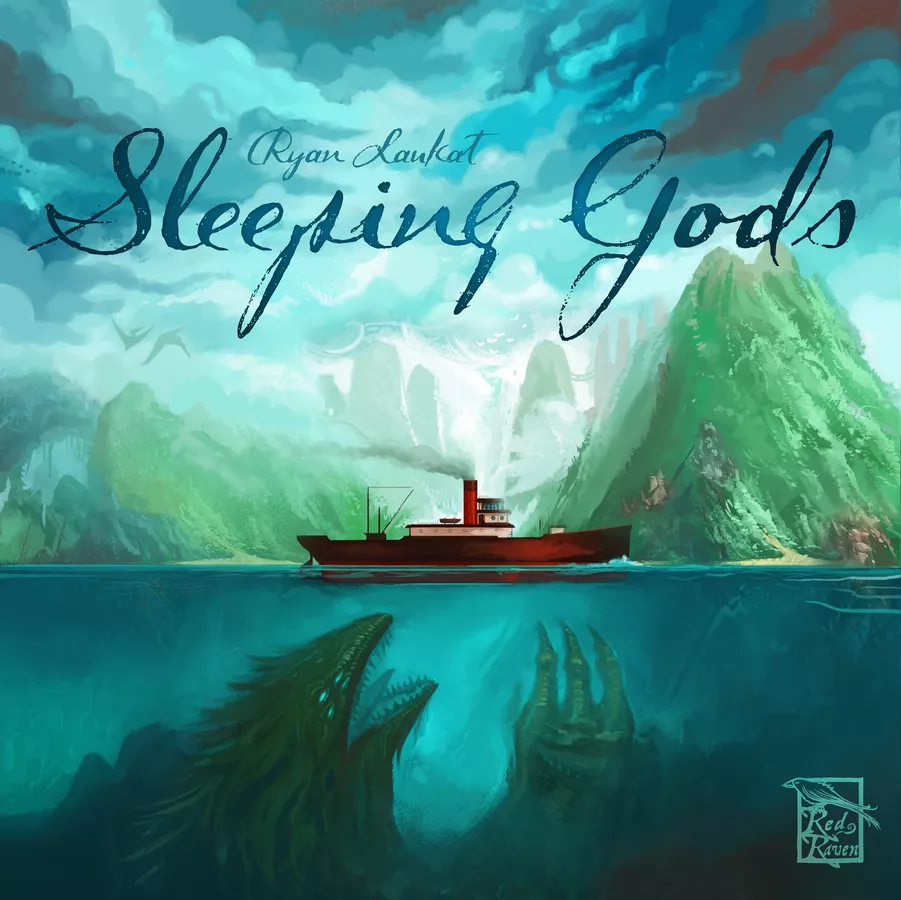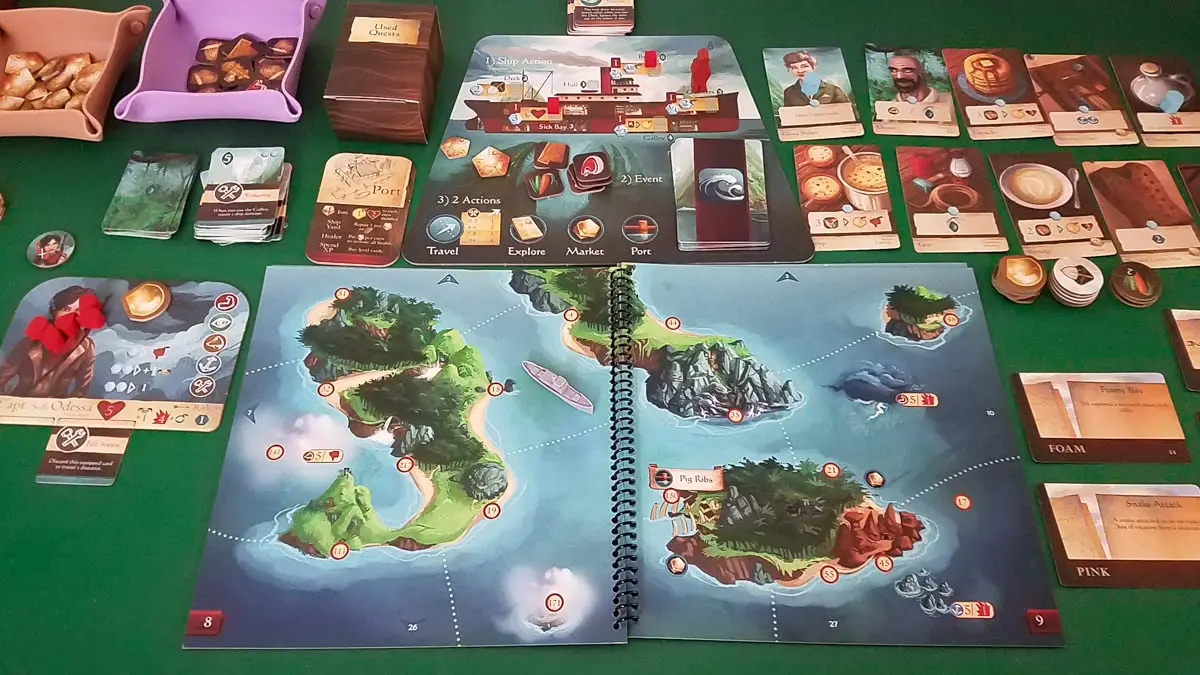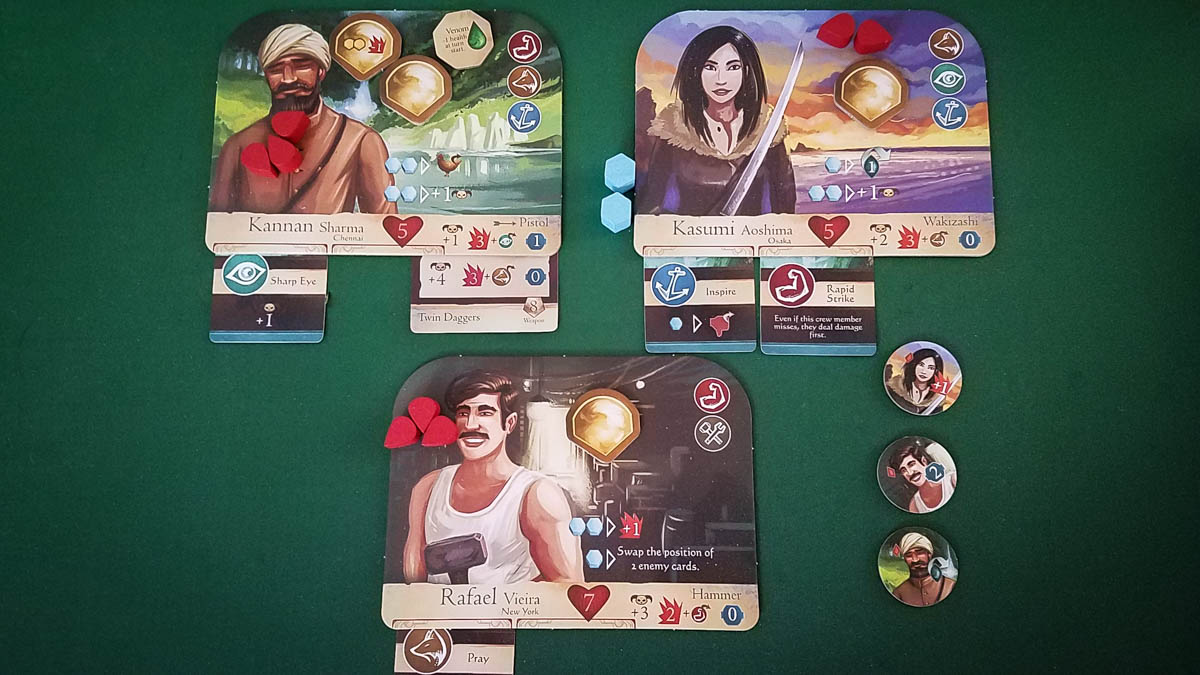Sleeping Gods Review
Year: 2021 | Players: 1-4 | Minutes: 60+ | Ages: 13+
This Sleeping Gods review was made after playing through the campaign once. We received a copy of this game from the publisher in exchange for an honest review.
What is Sleeping Gods?
Sleeping Gods is a cooperative, storytelling, adventure board game in which you play as Captain Sofi Odessa and her crew as they attempt to escape a strange world. Your goal is to find totems so you can wake the sleeping gods and get back home.
Sleeping Gods was designed by Ryan Laukat and is published by Red Raven Games.
Rules Overview
In Sleeping Gods, you play as Captain Sofi Odessa and her crew, who are stuck in a strange world in 1929. You take your ship to different locations around this world, attempting to find totems so you can wake the sleeping gods and get back to your world. Along the way, you’ll have to find food, weapons, gold, and other items that will help you complete quests.
Each player controls part of the crew and anyone can use Captain Odessa on their turn. Crew members have their own unique sets of skills, abilities, and stats. Each turn consists of three steps.
First, you take a quick worker placement action aboard your ship to help your crew in multiple ways. You can’t go to the same ship room two turns in a row and rooms can sustain damage throughout the game, limiting your available actions until you do repairs.
The second step involves drawing a card from the Event deck, which will either be an instant effect or an ongoing effect. The game ends after going through the deck three times.
The final step is the key step to each turn. You choose two actions from four options: Move, Port, Market, and Explore. The game’s maps are filled with locations to explore, markets where you can shop, and ports to rest and recover. The most common action is Explore, where you choose an adjacent location, read an encounter from the storybook, and face challenges, puzzles, quests, and enemies.
In combat, you select specific enemies, shuffle their cards, and place them side by side. Each enemy card has a grid with icons representing health, attack damage, special abilities, and bonuses. You need to cover all of the enemies’ heart symbols to defeat them; otherwise, they counterattack.
When facing challenges, you draw an Ability card and check its Fate number, which can be combined with a crew member’s skills to see if the challenge was a success or failure. Ability cards can also be equipped to the crew, giving them increased skill levels and new special abilities.
The Command tokens are another big part of the game. You use them to equip new cards, activate abilities, and for co-op actions.
Quest cards are gained throughout the adventure. These cards have keywords on them, which can sometimes give you access to more options in the storybook.
The Adventure deck has characters and items, including totems, that you can get throughout the game. The totems are your key to returning home and greatly influence your final score. There are campaign tracking sheets with a world map to help you keep track of your adventures, including the locations of the totems you found.
The ending you’ll get will depend on how many totems you find during your adventure. After you’ve finished a campaign, you’ll unlock Achievement cards, which you can use in all future campaigns.
That’s just a very basic overview of the Sleeping Gods rules. Go here to see the rulebook and other info about the game.
Pros and Cons
Pros
- Sleeping Gods has a true open-world feel, which is something that I’ve only felt in a few other board games. It makes exploration genuinely exciting and it makes you feel more in control of how everything plays out.
- Each of the crew members definitely has a different feel to them. A lot of co-op games have unique characters, but it’s especially cool in Sleeping Gods because each player has a different group of unique characters. This does a lot toward making each player feel important to the team since they have a collection of abilities and stats that the others don’t.
- The Command system works well. There’s a little bit of worker placement with it, which is always fun, but the best part about this system is that it forces you to think about how to use your tokens. Do you activate an ability or do you wait to use your token on a co-op action? It’s yet another thing that makes you feel like you’re in control over your crew’s part of the story.
- The Quest card/keyword system is simple but satisfying. It feels great when the storybook asks if you have a keyword and you look over to see that you do. It’s also sometimes a much-needed guide for you to use since it lets you know what keywords you should be looking for.
- I like this type of puzzly combat system. It’s not just rolling dice and seeing what happens. You have to come up with a way to limit what the enemies can do on their counterattacks. It’s definitely a more interesting system than you’d expect from a storytelling game.
- I’ve always been a fan of Ryan Laukat’s art, but Sleeping Gods is his best work in that department, in my opinion. The map and cards have a bright, kind of mobile-gamey look to them that everyone seems to like.
- There’s a good intro scenario to get used to Sleeping Gods’ core mechanisms. This made teaching the game a lot easier for me.
- It’s very easy to drop in and drop out of this game. We had to do this multiple times and it was super simple to jump right back into the game.
Cons
- I wish there was a way to escape combat challenges when you know you’re not ready for them. I would have preferred having the option to accept a small penalty for leaving rather than having to waste time on what we already knew was going to be a loss.
- Sleeping Gods takes up a lot of space on the table, especially once you’re hours into your campaign. This isn’t a big deal if you have the space, but I attempted to play this on a medium-sized table with two other people one night and it was very cramped.
- I think the journey logs–the campaign sheets that you use to track your progress–could have been a bit bigger. The map side of the log is there to help you track stuff you’ve found, including keywords, but there isn’t much space to work with.
- This wasn’t really a problem for me, but a couple of people I played with had a tough time getting used to the iconography in Sleeping Gods. They had an especially hard time remembering what the accuracy symbol meant.
Final Thoughts
Sleeping Gods is the best storytelling game that I’ve ever played and one of the best cooperative board games I’ve played, period. There’s a lot more “game” in Sleeping Gods than in other narrative games, and everyone I played it with got completely sucked into the story.
I don’t know how much replay value Sleeping Gods is going to have for my group since we got a pretty satisfying ending from our first campaign, but that doesn’t really matter to me. It was a ton of fun to play, I got about 15 hours of enjoyment out of it, and it’s one of the most memorable gaming experiences I’ve had in the last four or so years. This is an awesome board game.
- Update 1: Sleeping Gods has already been added to the Best Co-op Board Games and the Best Adventure Board Games lists!
- Update 2: It’s also now on the Best Storytelling Games list!
Sleeping Gods Links
BGG | Amazon | Miniature Market
Thanks for taking the time to read our Sleeping Gods review!
Be sure to also take a look at our Best Cooperative Board Games list and other rankings.
Subscribe to our newsletter if you want more co-op board game content sent right to your inbox!



